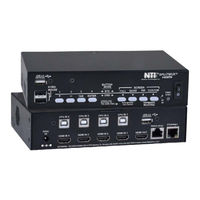NTI SPLITMUX Series SPLITMUX-HD-4RT-R Manuals
Manuals and User Guides for NTI SPLITMUX Series SPLITMUX-HD-4RT-R. We have 2 NTI SPLITMUX Series SPLITMUX-HD-4RT-R manuals available for free PDF download: Installation And Operation Manual
NTI SPLITMUX Series SPLITMUX-HD-4RT-R Installation And Operation Manual (81 pages)
Quad Screen Video Splitter
Brand: NTI
|
Category: Accessories
|
Size: 3 MB
Table of Contents
Advertisement
NTI SPLITMUX Series SPLITMUX-HD-4RT-R Installation And Operation Manual (75 pages)
SPLITMUX Series Quad Screen Video Splitter
Brand: NTI
|
Category: Recording Equipment
|
Size: 4 MB
Table of Contents
Advertisement

